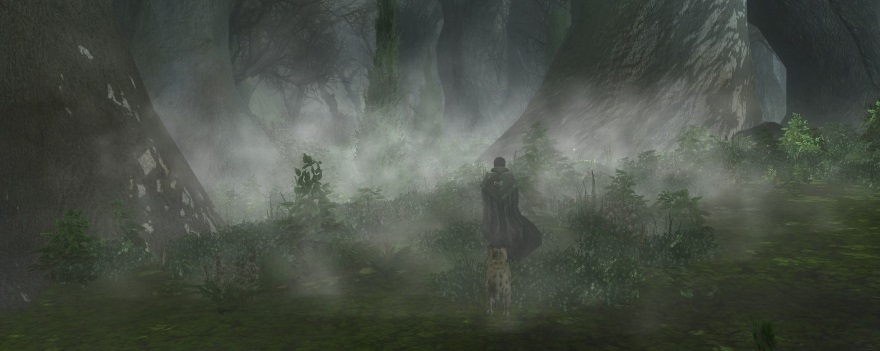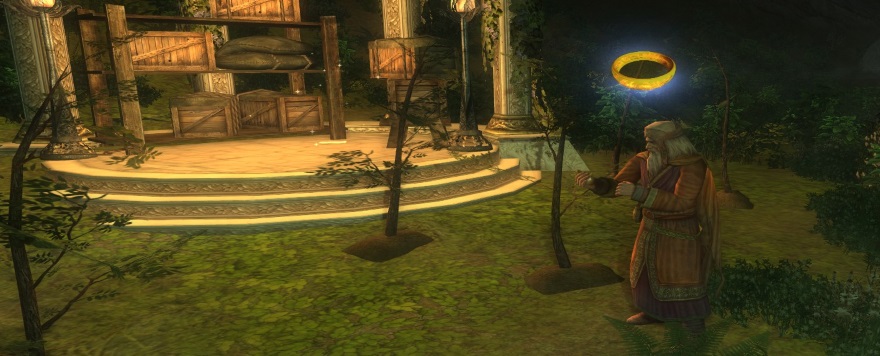
And then… and then we knew we were finally headed into Mordor. That in itself was a monumental moment for many players, and I lost track of how many friends I saw taking screenshots of themselves “walking into Mordor.”
Unfortunately, this ultimate moment of storytelling in a story-heavy, IP-grounded game ended up being a disappointment. Mild for some, crushing for others. From my perspective, I say without malice that Mordor, as an expansion and a region, failed. Today we’re going to touch on the multiple reasons why this is, as well as how Standing Stone Games is getting its groove back with Northern Mirkwood.

Where evil does not sleep
From start to finish, Mordor just didn’t work. It didn’t work from as a product, it didn’t work as a worthy expansion to the game, and it didn’t work as storytelling. From my personal observations and reading those of many others, I don’t think that there’s a single point of failure but rather a slew of missteps.
I have a particular point I want to focus on, so I’m going to list the others really quickly here. Mordor didn’t quite work due to:
- A lackluster promotional campaign
- An absolutely hideous trailer
- Overaggressive business model practices including ludicrously priced editions and a proliferation of lockboxes
- Very, very few stable masters and milestones, which necessitated a lot of foot travel
- Far too much backtracking
- Terrain that was difficult to navigate
- Mob density and difficulty
- Too many indoor zones that were slog-fests to complete
- A storyline with too many villains (see the third installment of any superhero movie series)
I’m still on the fence about bringing us into Mordor after the destruction of the One Ring. I mean, I really do understand why it had to happen from a design and story standpoint. It’s kind of neat to find out what happened next and to see the aftermath of Sauron’s downfall. But it also felt — and correct me if I’m alone on this — that the actual destruction was so quick that it was downright anti-climactic. Especially when you consider that we’ve been spending years building up to this very moment in all of the struggles and journeys we’ve undertaken.
While all of these are legitimate factors, the one I want to focus on today and contrast with LOTRO’s newest update is the environment and setting.

Volcanos, spiders, and green pools of death
I feel like I have to be careful here, because every time I’ve tried to express my disappointment with Mordor’s landscape, the common response is, “Dude, it’s Mordor! What did you expect, rainbows and sunshine? It’s supposed to be dour and malevolent!”
I acknowledge and understand that. I know that it’s important for MMOs to have more sinister areas that telegraph evil’s presence and to put players on their guard. And Mordor is arguably the most iconic evil country in all of fantasy literature.
But that doesn’t make it a fun, enjoyable, or compelling place to visit. The problem here is not that Mordor is covered with lava, ash, spiderwebs, and green pools of death, it’s that the developers plunked us down in this region for a long, long time. You cannot blitz through Mordor. It’s a long campaign that covers five expansive zones, and most all of that time you’re dwelling in an environment that might as well be the poster child for the apocalypse.
It’s so dreary and so depressing that I actually cheered when I got to visit the couple of areas that had trees — dead and sagging though they were. Giving LOTRO its due, the artists can really sell the ugly and corrupt parts of Middle-earth as well as the good — but it doesn’t mean that we want to marinate in those regions for days, weeks, and even months.
It reminds me of why I and many others avoid Angmar like the plague. It also recalls the era where we were stuck in Moria for a long time and ended up feeling claustrophobic and irrationally angry by the end.
The solution, which I think SSG is only now catching on to, is that Mordor should have been taken in small doses instead of a lengthy, continuous journey. There also needed to be more of a sense of civilization returning, too. We meet far too few friendly NPCs and camps along the way, and for obvious reasons, we don’t really identify with the enemy hordes still roaming around.
If SSG is going to continue to expand Mordor, I’d like to see some of the regions that aren’t as blasted or antagonistic, too. There has to be regions where food is grown, trees are chopped down, and people exist. Those would be interesting to see.

Life after Mordor
The result of all of the above was that Mordor, despite any great intentions on behalf of the developers, didn’t feel at all like the LOTRO that I fell in love with many years ago. I didn’t want to explore that region, but merely endure it until I could escape it.
Happily, escape I did, right into Update 22 and Northern Mirkwood. I cannot tell you what a relief it was to not just get out of Mordor, but to rediscover the beauty and life that infuses so much of this MMO. Unlike Southern Mirkwood (which I love for different reasons), the northern region is much more verdant and vibrant. As I rode under the giant leafy canopy and listened to the ambient noises of forest life, I felt relaxed and jovial once more.
I love that one of the very first things that you do in Northern Mirkwood is to visit the Halls of the Elven-king. Not because Elves are awesome, as they are not, but because it brought us back in the cradle of civilization that Mordor so severely lacked. The world of LOTRO isn’t merely small quest hubs and the occasional capital city; it’s a place with a lot more history and life to it than the usual MMO. It’s a world that’s populated and, to some extent, settled, with countries and cultures that carry continuity across them. Apologies for unintended alliteration there.
The lush green forest and this bizarrely beautiful cave city were what I had been missing in this game. LOTRO, to me, isn’t Angmar or dungeons or charging up Mt. Doom. It’s the daily life of the Shire, the quaint feel of Bree-land, the proud history of Rohan, the striking visuals of Lothlorien, and the seaside vistas of Gondor. There are evil places and evil forces, yes, but even in high-level zones, it’s good to see that beauty and civilization endure and haven’t been abandoned because the devs want to make the scariest and most foreboding place imaginable.
If you find yourself despairing as you plod through Mordor, then take heart: There is a great journey ahead of you afterward! And if the recent producer’s letter is any indication, we’ll be sticking around in the north all year long. That is completely fine by me.
 Every two weeks, the LOTRO Legendarium goes on an adventure (horrid things, those) through the wondrous, terrifying, inspiring, and, well, legendary online world of Middle-earth. Justin has been playing LOTRO since its launch in 2007! If you have a topic for the column, send it to him at justin@massivelyop.com.
Every two weeks, the LOTRO Legendarium goes on an adventure (horrid things, those) through the wondrous, terrifying, inspiring, and, well, legendary online world of Middle-earth. Justin has been playing LOTRO since its launch in 2007! If you have a topic for the column, send it to him at justin@massivelyop.com.













